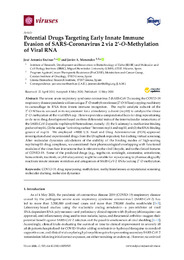Por favor, use este identificador para citar o enlazar este ítem:
https://hdl.handle.net/11000/30649Registro completo de metadatos
| Campo DC | Valor | Lengua/Idioma |
|---|---|---|
| dc.contributor.author | Encinar, José Antonio | - |
| dc.contributor.author | MENÉNDEZ MENÉNDEZ, JAVIER ABEL | - |
| dc.contributor.other | Departamentos de la UMH::Bioquímica y Biología Molecular | es_ES |
| dc.date.accessioned | 2024-01-26T08:56:21Z | - |
| dc.date.available | 2024-01-26T08:56:21Z | - |
| dc.date.created | 2020-05-08 | - |
| dc.identifier.citation | Viruses 2020, 12(5), 525 | es_ES |
| dc.identifier.issn | 1999-4915 | - |
| dc.identifier.uri | https://hdl.handle.net/11000/30649 | - |
| dc.description.abstract | The severe acute respiratory syndrome coronavirus-2 (SARS-CoV-2) causing the COVID-19 respiratory disease pandemic utilizes unique 20-O-methyltransferase (20-O-MTase) capping machinery to camouflage its RNA from innate immune recognition. The nsp16 catalytic subunit of the 20-O-MTase is unusual in its requirement for a stimulatory subunit (nsp10) to catalyze the ribose 20-O-methylation of the viral RNA cap. Here we provide a computational basis for drug repositioning or de novo drug development based on three di erential traits of the intermolecular interactions of the SARS-CoV-2-specific nsp16/nsp10 heterodimer, namely: (1) the S-adenosyl-l-methionine-binding pocket of nsp16, (2) the unique “activating surface” between nsp16 and nsp10, and (3) the RNA-binding groove of nsp16. We employed 9000 U.S. Food and Drug Administration (FDA)-approved investigational and experimental drugs from the DrugBank repository for docking virtual screening. After molecular dynamics calculations of the stability of the binding modes of high-scoring nsp16/nsp10–drug complexes, we considered their pharmacological overlapping with functional modules of the virus–host interactome that is relevant to the viral lifecycle, and to the clinical features of COVID-19. Some of the predicted drugs (e.g., tegobuvir, sonidegib, siramesine, antrafenine, bemcentinib, itacitinib, or phthalocyanine) might be suitable for repurposing to pharmacologically reactivate innate immune restriction and antagonism of SARS-CoV-2 RNAs lacking 20-O-methylation. | es_ES |
| dc.format | application/pdf | es_ES |
| dc.format.extent | 25 | es_ES |
| dc.language.iso | eng | es_ES |
| dc.publisher | MDPI | es_ES |
| dc.rights | info:eu-repo/semantics/openAccess | es_ES |
| dc.rights | Attribution-NonCommercial-NoDerivatives 4.0 Internacional | * |
| dc.rights.uri | http://creativecommons.org/licenses/by-nc-nd/4.0/ | * |
| dc.subject | COVID-19 | es_ES |
| dc.subject | drug repurposing | es_ES |
| dc.subject | methylation | es_ES |
| dc.subject | methyltransferases | es_ES |
| dc.subject | computational screening | es_ES |
| dc.subject | molecular docking | es_ES |
| dc.subject | molecular dynamics | es_ES |
| dc.subject.classification | Bioquímica y Biología Molecular | es_ES |
| dc.subject.other | CDU::5 - Ciencias puras y naturales::57 - Biología::577 - Bioquímica. Biología molecular. Biofísica | es_ES |
| dc.title | Potential Drugs Targeting Early Innate Immune Evasion of SARS-Coronavirus 2 via 2’-O-Methylation of Viral RNA | es_ES |
| dc.type | info:eu-repo/semantics/article | es_ES |
| dc.relation.publisherversion | https://doi.org/10.3390/v12050525 | es_ES |

Ver/Abrir:
viruses-12-00525-v3.pdf
3,62 MB
Adobe PDF
Compartir:
 La licencia se describe como: Atribución-NonComercial-NoDerivada 4.0 Internacional.
La licencia se describe como: Atribución-NonComercial-NoDerivada 4.0 Internacional.
.png)